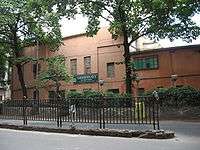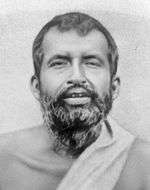Ramakrishna Math

Ramakrishna Math is a religious monastic order, considered part of the Hindu reform movements. It was set up by Swami Vivekananda based on the teachings of Sri Ramakrishna in Kolkata, India. The Ramakrishna Math is headquartered at Belur Math (in West Bengal, India), and shares the location with the related organisation, the Ramakrishna Mission.
It also has Advaita Ashrama branches at Mayavati, near Almora and in Kolkata.
Monastic order

Ramakrishna Math consists of monks (Sannyasins and Brahmacharins) belonging to a monastic order for men. After the passing away of their Master Sri Ramakrishna in 1886 the young disciples under the leadership of Swami Vivekananda organized themselves into a new monastic order. The original monastery at Baranagar called Baranagar Math was shifted in January 1899 to a newly acquired plot of land at Belur in the district of Howrah.
The Genesis''' [1] During his lifetime, Ramakrishna gathered and trained his young disciples with Narendranath (future Vivekananda) as their anointed leader. It is these disciples - some of whom were also blessed with monastic robes by Ramakrishna himself, that formed the core of a new monastic order that bears his name now. Swami Vivekananda and sixteen others were the founders of this order. After taking formal monastic vows through appropriate rituals (12 at first and the rest at different times later) they assumed new names as follows (based on seniority in age):
* Gopal - Swami Advaitananda (1828-1909) * Taraknath - Swami Sivananda (1854-1934) * Baburam - Swami Premananda (1861-1918) * Yogindra - Swami Yogananda (1861-1899) * Harinath - Swami Turiyananda (1863-1922) * Narendranath - Swami Vivekananda (1863-1902) * Rakhal - Swami Brahmananda (1863-1922) * Sasibhusan - Swami Ramakrishnananda (1863-1911) * Tulasi - Swami Nirmalananda ( 1863-1938) * Gangadhar - Swami Akhandananda (1864-1937) * Kaliprasad - Swami Abhedananda (1866-1939) * Saratchandra - Swami Saradananda (1865-1927) * Saradaprasanna - Swami Trigunatitananda (1865-1914) * Subodhachandra - Swami Subhodananda (1867-1932) * Hariprasanna - Swami Vijnanananda (1868-1938) * Latu - Swami Adbhutananda (died 1920) * Nityaniranjan - Swami Niranjanananda (died 1904)
Belur Math
- See main article Belur Math
This monastery, known as Belur Math, serves as the Mother House for all the monks of Ramakrishna Order who live in the various branch centres of Ramakrishna Math and/or the related Ramakrishna Mission in different parts of India and the world.
The Motto and the Emblem[2]
.jpg)
Any organisation, especially the one that bears the name of an epoch-making person, needs a motto to guide it and an emblem that constantly reminds and inspires. Realising this, Vivekananda placed before it the motto: आत्मनो मोक्षार्थम् जगद्धिताय च - Atmano Mokshartham jagaddhitaya ca ('For the liberation of the Self and service to the society'). He also designed a charming but distinctive emblem that effectively reflected this motto. It consists of an elegant swan against the backdrop of the rising sun, surrounded by wavy waters from which has arisen a beautiful lotus flower along with a couple of leaves. This whole picture is encircled by a hooded serpent.
Whereas the motto adds a social dimension to the hitherto, purely personal, aspect of a self-centred sadhana, the emblem - which graphically describes a balanced combination or harmony of all the four yogas - enriches that sadhana by making it more comprehensive.[3]
Swami Vivekananda explained the imagery in the following terms: "The wavy waters in the picture are symbolic of Karma; the lotus, of Bhakti; and the rising-sun, of Jnana. The encircling serpent is indicative of Yoga and the awakened Kundalini Shakti, while the swan in the picture stands for Paramatman (Supreme Self). Therefore, the idea of the picture is that by the union of Karma, Jnana, Bhakti and Yoga, the vision of Paramatman is obtained."[4]
The Bifurcation
The basic philosophy of life put before the Ramakrishna Order by Vivekananda automatically led to a bifurcation of its activities into two important, but parallel, areas. The atmamoksha aspect resulted in the establishment of the Ramakrishna Math, an organisation catering predominantly to the spiritual needs of the monks of the order as also its votaries. The jagaddhita aspect on the other hand, gave rise to another, a sister organisation, concentrating solely on public service activities.
The Philosophy of Vedanta

The fundamental truth as taught by all religions is that man has to transform his base human nature into the divine that is within him. In other words, he must reach the deeper strata of his being, wherein lies his unity with all mankind. And Vedanta can help us to contact and live that truth which unfolds our real nature — the divinity lying hidden in man.
Vedanta is not a particular religion but a philosophy which includes the basic truths of all religions. It teaches that man’s real nature is divine; that it is the aim of man’s life on earth to unfold and manifest the hidden Godhead within him; and that truth is universal...
Thus Vedanta preaches a universal message, the message of harmony. In its insistence on personal experience of the truth of God, on the divinity of man, and the universality of truth it has kept the spirit of religion alive since the age of the Vedas (ancient scriptures). Even in our time there have been Ramakrishna, Vivekananda, and men like Gandhi. The modern apostle of Vedanta, Vivekananda, describes the ideal religion of tomorrow as follows:
Vivekananda on the Ideal Religion of Tomorrow
If there is ever to be a universal religion it would be one that would occur within the confines of a palace of no location or time. This palace will be infinite and within these walls God will preach its holy sum. Its warm rays will shine down upon the followers of Krishna, Mohammed, Christ, Buddhists, and all teachers alike. These walls will ever grow to encompass the infinite space of the soothing heart. This religion will know that every virtue of man is to be held and witnessed all from the grovelling savage not far removed from the brute, to the highest man. It will be here that standing still, towered by the virtues of his head and heart will he remain making society stand in awe of him. It will be his religion where there shall be no space for persecution or intolerance within its politic. It will be a place which will recognize its divinity in every man and woman and whose whole scope and force will be centered in aiding humanity to realize its own true point.
Each Religion is a Path
This "sum total" of all religions does not mean that all people on earth have to come under the banner of one prophet or worship one aspect of God. If Christ is true, Krishna and Buddha are also true. Let there be many teachers, many scriptures; let there be churches, temples, and synagogues. Every religion is a path to reach the same goal. When the goal is reached the Christian, the Jew, the Islamist, the Hindu, and the Buddhist realize that each has worshiped the same Reality. One who has attained this knowledge is no longer a follower of a particular path or a particular religion. He has become a man of God and a blessing to mankind.
Management
The Ramakrishna Math was registered as a Trust in 1901. The management of the Math is vested in a Board of Trustees who are only monks. The Math with its branches is a distinct legal entity. It has well defined rules of procedure. It lays emphasis on religious practices and preaching of Dharma. The Math has its own separate funds and keep detailed accounts which are annually audited by qualified chartered accountants. It has 57 Branch centres in India and abroad. The Math and the Mission both have their Headquarters at Belur Math.1
See also
References
- ↑ A Concise Encyclopaedia of Hinduism, Swami Harshananda
- ↑ Swami Harshananda, The Concise Encyclopaedia of Hinduism
- ↑ Swami Harshananda, The Concise Encyclopaedia of Hinduism, Vol.3 p.21
- ↑ Vivekananda, Swami. "Conversations And Dialogues - XVI". The Complete Works of Swami Vivekananda 7. Advaita Ashrama.
External links
| Wikimedia Commons has media related to Ramakrishna Mission. |
| |||||||||||||||||||||||||||||||||||||||||||||||||||
| ||||||||||||||

